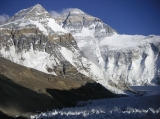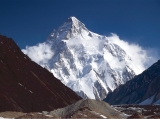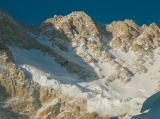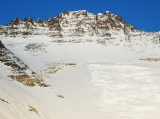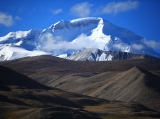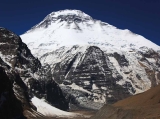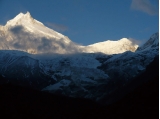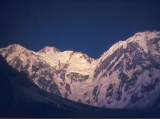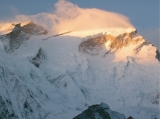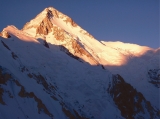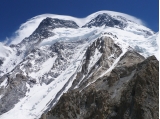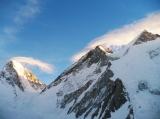
Climbing the Fourteen Peaks: What the Eight-thousanders Mean to One Climber
Hirotaka Takeuchi
Climber
In a world of extremes, where life and death are very near to the same thing, climber Hirotaka Takeuchi continued his challenge. In testing his own limits, he pulled through with a ruggedly handsome smile on his face.
In May of this year, Takeuchi became the first Japanese climber to successfully reach the summits of all fourteen of the "eight-thousanders" (all peaks over 8000 meters in the Himalayas). By finally bringing a successful close to this challenge that has spanned the eighteen years since he summited Makalu in 1995, he became the 29th person to ever reach all fourteen summits.
Word of Takeuchi’s achievement has of course gotten around the climbing community, and has aroused quite a bit of excitement and emotion in Japan.
The man who accomplished it, though, is remarkably calm.
“I don’t really see how it means anything that I'm the first Japanese to do it," he explained.
What feelings and thoughts now fill the heart and mind of this professional mountain climber?
Mountain Climbing Is About Loops
How did it feel to finally stand atop the summit of Dhaulagiri, the last of the fourteen peaks?
For sure, I just wanted to get back right away. That wasn’t the only one. I got the same feeling from all the other eight-thousanders, too. Mountain summits are places with very little life, so it’s fairly unnatural for a human being to be there. It can even become a sort of feeling of crisis, like you are holding your breath to exist. That’s why the moment I step up onto the summit, I start to feel the need to get down, to get away from that place. It’s a place that isn’t meant to support human life, so you can’t stay there for very long.
 At the top of Dhaulagiri in 2012, sealing his success in climbing the fourteen peaks Photo: Hirotaka Takeuchi
At the top of Dhaulagiri in 2012, sealing his success in climbing the fourteen peaks Photo: Hirotaka Takeuchi
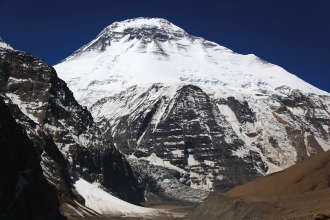 Dhaulagiri, the seventh highest peak on Earth at 8167 meters
Dhaulagiri, the seventh highest peak on Earth at 8167 meters
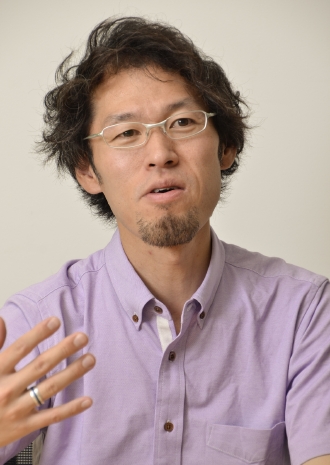
Do you mean that you don’t feel swept up by a sense of achievement or satisfaction?
Dhaulagiri is a great mountain, and it’s one I’ve wanted to climb for a long time. I’ll tell you, that is one good-looking mountain. Still, as soon as I got there, I wanted to get out of there right away. I think it’s only those that feel that sense of their lives being in danger that are always going to be able to come back down. There is a thing they call “climber’s high.” But I think that if you let the achievement and satisfaction get to you, you put yourself in the dangerous position of not being able to make proper judgments.
At least so far, I haven’t had that. I think that rather than saying that’s what allows me to climb, I’d say that it’s what has allowed me to come back down. If you can’t get back to the base camp, if you don’t get at least back down to there, you won’t make it up the next mountain. Without this repetition of ascent and descent, you can’t reach all fourteen of those peaks. So the way I look at it, the achievement is not in having climbed it, but in having been able to make it back down.
So you see being able to come down alive as a bigger achievement than reaching the top, is that right?
That’s right. You see, I think of mountain climbing as being more of a loop than a simple ascent. At one point on the loop, there is a span of maybe five or ten minutes where you are standing on the summit. It’s difficult for me to think of that brief moment in the middle as the achievement. It’s not the climax, and it’s not even really much of a highlight in terms of the climb as a whole.
I feel like there are bigger loops than that, though, too. If you think of the loop as starting from the conception of the climb, or the desire to climb a given mountain, then it begins with thinking about things like: what should I take? What should I wear? Or: maybe I should make the strap on that axe just a little bit shorter. At that point, the loop has already begun. All kinds of things can happen just on the trip to base camp.
When you start to think about the next mountain you want to climb, you're beginning the next loop. Climbing for me has always been an ongoing cycle like that.
I’ve closed up loop after loop like that, and Dhaulagiri was just closing the loop on the fourteen peaks as a whole. That’s one way I think about it.
What Climbing the Fourteen Peaks Means to Takeuchi
Does completing the summit of all fourteen peaks have a lot of significance?
In terms of records, it’s something that’s been done again and again already. It’s already been 25 years since the Italian climber Reinhold Messner completed his summit of the fourteen peaks in 1986.With nearly thirty people having done it, it’s not that rare or special of a record. I myself have been able to observe some of the other climbers who have done it from a close distance. I didn’t do all of it without oxygen, so as a record, it’s pretty unremarkable.
If Noboru Yamada1 had been able to do it when he died in 1989, he would have been the third or fourth person in the world to do so. It would have been much more significant to the climbing world for him to do have done it then than it is for me to do it now. But now, with so many people having already accomplished it, I don't really think that my being the first Japanese to do so is anything special. This is something that all humans do, so nationality doesn’t have anything to do with it.
Still, it's true that it’s a really, really special thing to the Japanese. It was a big problem that no Japanese had as yet achieved this record that had long been already achieved by so many others globally, and I thought it was such a shame, I had to do something. Even though it was a Japanese team that first summited Manaslu. I thought it was such a shame that he didn't make it, because he had put himself in a position to take on the fourteen peaks.
I was beginning to fear that everyone who had lost their lives in challenging the fourteen peaks, like Yamada and Hideji Nazuka2, might be forgotten. I think there’s something really noble in the loss of their lives in that pursuit. It was incredibly galling to me that people seemed to be forgetting the achievements of Yamada and Nazuka, and were beginning to lose interest in Japanese climbers because not one had summited the fourteen peaks. So I took it upon myself to do it.
1. Noboru Yamada, a Himalaya mountaineer born in 1950. Summited nine of the peaks in all, twelve times among them. Yamada died in an accident while climbing McKinley in Alaska in the winter of 1989.
2. Hideji Nazuka, a Himalaya mountaineer born in 1956. Summited nine of the peaks. Nazuka died in an avalanche climbing the tenth peak, Annapurna I, in 2004.
So the fourteen peaks weren’t your main goal from the start?
Right, not from the beginning, they weren’t. It wasn’t until I met my climbing partners, Ralf from Germany and Gerlinde from Austria, and the three of us decided to do the fourteen peaks together that I realized I could become the first Japanese to summit the fourteen peaks, and do something to celebrate the achievements of Yamada, Nazuka, and others who came before me. With this in mind, summiting these peaks became a really special, important thing to me. And now I’ve finally finished doing that.
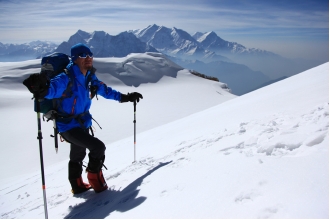 Dhaulagiri, at nearly 6500 meters, Annapurna seen far off in the distance Photo: Kenro Nakajima
Dhaulagiri, at nearly 6500 meters, Annapurna seen far off in the distance Photo: Kenro Nakajima
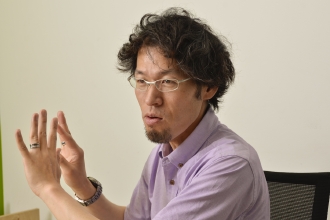
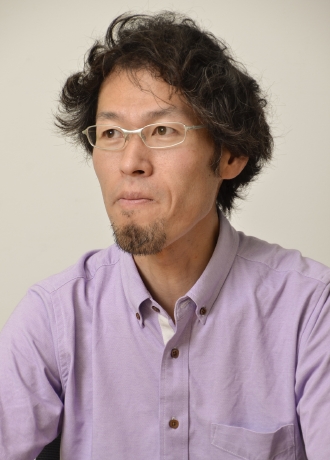
In 2007, you got caught in an avalanche on Gasherbrum II that left you severely injured, including a fractured spine. What motivated you to continue your challenge to master those peaks?
Well, I didn’t really have any kind of special motivation. The truth is, I was dead there on Gasherbrum. There just happened to be some others there who were able to save me, and that’s the only reason I’m here today. This life I have now is something that they gave to me. It’s something the mountains gave to me. That’s why I want to devote it all to the mountains.
With all that, weren’t you afraid to face the mountains again?
No, not really. I am human, so I might have been afraid somewhere deep inside. I think that my will to climb again far exceeded that, though. It’s not mountain climbing unless you can climb up and climb back down by yourself. I didn’t come down Gasherbrum by my own power. That doesn’t fit with what it means to me to climb mountains, and I was just disgusted and irritated.
It was just my own way of thinking of it, but I knew that I wouldn’t be satisfied until I at least got up to where the accident had happened and descended again on my own. I didn’t feel it would be right for me to go on living without doing at least that. That alone gave me a rush of this indescribable feeling when I took Gasherbrum on again.
What was that feeling like?
I wept. I didn’t cry for any one reason, like sadness, pain, regret, happiness, or anything else like that. It was more like I just had to do shed tears to completely empty my head from all of the things with which it had become so full.
The media has been calling this climbing just a year after your injuries a “miraculous recovery." What do you think about that?
That’s just sensationalism. I had already decided the year before to go back to Gasherbrum, and the period in which you can do it is predetermined. The period of time during which you can actually climb it is limited. I was set to leave Japan for the Himalayas whether the rehabilitation was all finished or not. I never expected in the first place that my body would be perfectly recovered, and I intended to go even if I had to crawl.
So first of all I made my way to the base camp. After reaching the base camp, I aimed first for camp one, and then camp two. I considered climbing to be part of the rehabilitation process.
It was sometime last year that I finally was fully recovered from the damage of those injuries. Still, it’s not the same body I had before the accident. It poses no impediment to my daily life, and poses no particular problems on the mountain either, the sensations in the nerves that run to the ends of the toes on my left foot and my right foot feel different. Aside from the broken spine, there was also the healing of these ribs that got deformed. (Here he lifts his shirt to show the ribs on his right side.)
Those ones on the right there are sticking right out, aren’t they.
It’s really pointing out, right? It starts to hurt when my breathing gets rough. It didn’t bother me much on Gasherbrum the years after the accident, but on when I was on Lhotse in 2009, about 500 meters higher than the top of Gasherbrum, your breathing gets rough no matter what. And boy, did it hurt then. It got even worse when I pushed on it with my hand to try to stop my chest from expanding as much. (He laughs.)
Speaking of pain and hardship, you also had to bivouac on Dhaulagiri this time as well, didn’t you? On the descent, the sun was setting, and a route to get back to camp three could not be found.
From the time we left camp three for the top, we were resigned to the fact that we would probably have to bivouac on the way back down if it got too late. Since we already knew that, we looked for a good spot where we might be able to do it on the way up. Mountain climbing is a sport of the imagination, and that’s what makes it really fun. You have to be able to take the mountain on by using your imagination on different levels and in different directions. The climbers with the most imagination have the most fun.
You might even be able to say that the whole thing depends on the ability of the climber to imagine it all, down to which routes they want to climb on which mountains. You can climb a mountain no one has climbed, using a route that no one has used before, with climbing methods that no one has ever used. The climbers who can think all that through are the ones that can actually make it happen. You could say that they compete using their imaginations.
A Japanese Mountain Climber Goes from Paralysis to Freedom
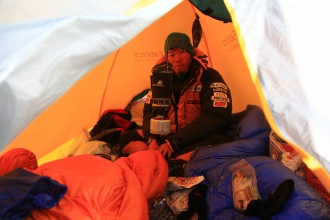 Dhaulagiri’s C2, at nearly 6600 meters Photo: Kenro Nakajima
Dhaulagiri’s C2, at nearly 6600 meters Photo: Kenro Nakajima
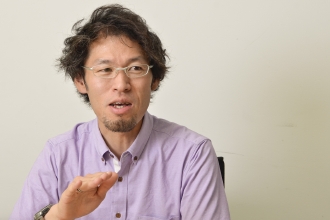
Have you already drawn up plans for your next goal?
I want to keep challenging myself to see how far I can climb. This climb of those fourteen peaks was definitely a part of that. Because I was saved from death to be allowed to continue on to climb those fourteen peaks, I can’t really consider myself as having climbed all fourteen of them. There is an endless number of mountains on the face of this Earth, so really, you could say that I have only actually climbed fourteen of them. So I couldn’t completely say that I’ve climbed them myself. I’ve been able to climb all the mountains I wanted up to know, and I hope that I’ll be able to continue doing just that. Whatever happens, from here on out, climbing is a brand new thing.
What do you mean by that?
Now that I have been able to do the fourteen peaks, I think that proves that there are some “old school” climbers left in Japan. Instead of the built up sort of mountain climbing that uses old things, with the achievement of summiting these fourteen peaks in the older way, it opens up the start of a new kind of climbing.
It would be great if people see what I did and for example, since I used oxygen on Makalu, Everest, and K2, try things like taking on the fourteen peaks completely without the use of extra oxygen, or taking the peaks on using a variety of new routes instead of the established normal routes.
This is how I will become a person of the past. The old era is over now. Rather than my own name, I want to leave the names of those fourteen Himalayan peaks in people’s minds. My hope is that my climbing might lead to even just a few more people who decide they want to go to the Himalayas, which they have probably never seen except in an atlas once, or who decide they want to at least go to Kathmandu, who think that they would like to try to climb those mountains themselves.
Even right now through doing this interview, by me talking about the Himalayas this way, there might be people who can envision it in three dimensions. I feel extremely fortunate to have been able to carry on my challenge of climbing the peaks. It’s a really blessed place that we're in, so even more than a duty or a calling, I consider this a role that must be filled by someone who has been doing it for some time.
So you plan to continue climbing even as you start to undertake such enlightened activities?
Up until the 90s, with old school climbing, you couldn’t do anything unless your organization had the money. But the truth is, now you can just decide to leave next week. Even in soccer, there are players that will hop on a plane and play all over the world. It’s the same idea. Climbers today are freer than they’ve ever been. I want to keep them going further.
Setting up base camp is like a building a huge secret fort with your friends. Planning what you’ll take, what you’ll do when you’re there, deciding what color the tablecloth should be, what pictures you’ll put up, isn’t that the part that’s the most fun?
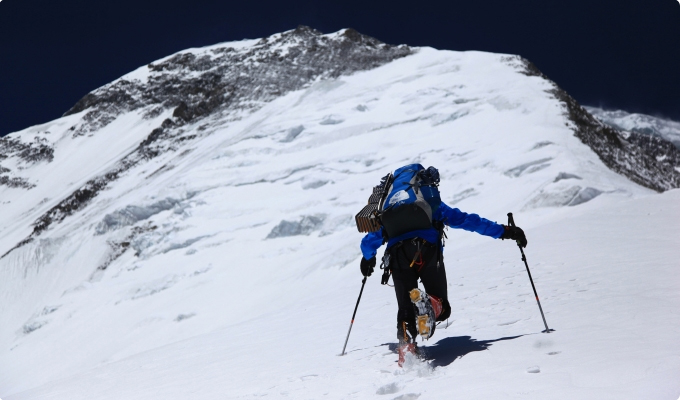 On Dhaulagiri, facing C2 at nearly 6500 meters Photo: Kenro Nakajima
On Dhaulagiri, facing C2 at nearly 6500 meters Photo: Kenro Nakajima
Fourteen peaks over 8000 meters
Photographs courtesy of the 14Project Office

Climber
Mountaineer, born January 8, 1971, Tokyo, Japan. Has enjoyed climbing and skiing from a young age, taking after his grandfather, who was fond of climbing. Attended Tokyo’s Hitotsubashi High School and Rissho University, studying climbing, and at twenty completed his first summit over 8000 meters. In 1995, he successfully climbed the lower eastern edge of Makalu, making the first step toward climbing all fourteen peaks. Ralf Dujmovits and Gerlinde Kaltenbrunner have been his main partners since 2001, and began making serious efforts to climb in the alpine style, working without the assistance of Sherpa guides or oxygen tanks. In May of 2012, with the successful summit of Dhaulagiri, he became the first Japanese climber to summit all fourteen Himalayan peaks over 8000 meters (the “eight-thousanders”).
Official home page:
http://weblog.hochi.co.jp/takeuchi/
Translation: Joe Boxman
Text:Kei Totsuka
Photos:Kiyoshi Tsuzuki(Interview)
ENG version: 2012/09/27
Original JPN version: 2012/08/30
INTERVIEW
-

What We Need to Face in Order to Combat Poverty around the World
Toshi Nakamura
Co-founder and CEO of Kopernik, a non-profit rganization
2013/3/07 -

Overcoming choppy waters in society and at sea
Venturing into a new world
Laura Dekker
Sailor
2013/1/17 -

Behind the scenes of a high-rise building climb
Alain Robert
"French Spiderman"/ Free climber
2012/11/01 -

Freedom and Courage
Alain Robert
"French Spiderman" / Free climber
2012/10/11 -

Climbing the Fourteen Peaks: What the Eight-thousanders Mean to One Climber
Hirotaka Takeuchi
Climber
2012/9/27 -

Writing a tale of adventure about living life under extreme conditions
Yusuke Kakuhata
Nonfiction Writer and Explorer
2012/8/30 -

The 110 Kilometer Ocean Swim To Strengthen the Bond Between Japan and Taiwan
Kazuya Suzuki
Ocean athlete
2012/7/26 -

Now more than ever, we need to get back to basics.
Mike Horn
Adventurer
2012/6/21

